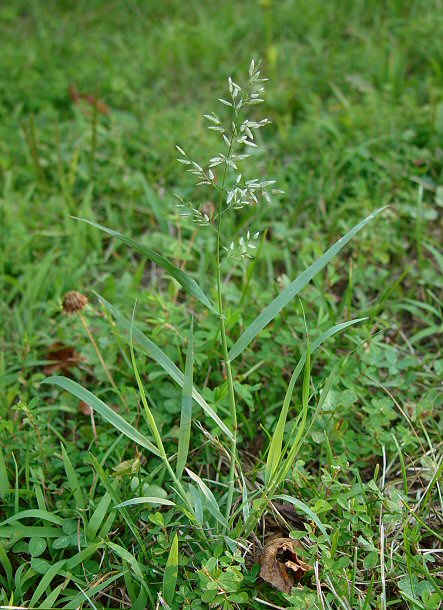Eragrostis cilianensis (All.) Vignolo ex Janch.
Stink Grass

Introduced
CC = *
CW = 3
MOC = 65
© DETenaglia
Eragrostis cilianensis (All.) Vignolo ex Janch.Stink Grass | |
 |
Introduced CC = * CW = 3 MOC = 65 |
© DETenaglia |
|
Family - Poaceae/Eragrostideae Habit - Annual grass with fibrous roots, forming tufts. Stems - To 40cm long, spreading to ascending, herbaceous, multiple from the base, glabrous but often with a small ring of glandular bumps below the nodes. Plants annual. Leaves - Blades to 20cm long, to 7mm broad, flat, glabrous. Leaf margins with many minute glands which can be felt or seen with a lens. Leaf bases with ciliate hairs. Sheaths glabrous but with glands on the margins, ciliate on the margins near the apex. Ligule a line of minute hairs to 1mm long.
Inflorescence - Paniculate arrangement of spikelets, fairly dense, to 15cm long, ovate in outline, with a slightly silvery-greyish cast. Branches of the inflorescence ascending to spreading, glabrous or with floccose axillary hairs, also with glands as the leaves.
Flowers - Spikelets to 15mm long, 2-4mm broad, oblong-lanceolate in outline, with typically 10-20 florets. Glumes of the florets to 2.3mm long, the upper slightly longer than the lower, both glumes typically glabrous but usually with glands. Lemmas to 2.8mm long, acute to acuminate at the apex, keeled, with glands along the midvein.
Flowering - June - October. Habitat - Streambanks, glades, fields, pastures, disturbed sites, roadsides, railroads. Origin - Native to Europe. Lookalikes - Other species of Eragrostis. Other info. - This weedy species is found throughout most of Missouri and across the continental U.S. The plant can be identified by its tufts of hairs at the base of the leaves and the small, warty glands which are present on leaf margins and stem nodes. There are numerous lookalikes, and details such as leaf width and spikelet size can be important. Distinguishing species in this genus can be challenging. Photographs taken in the Ozark Scenic Riverways, Shannon County, MO., 7-23-03 (DETenaglia); also along the Katy Trail near Dutzow, Warren County, MO, 8-16-2020 (SRTurner). |